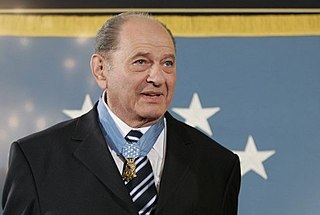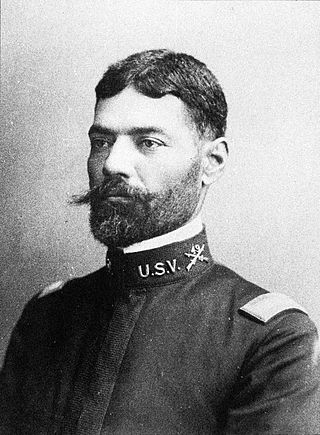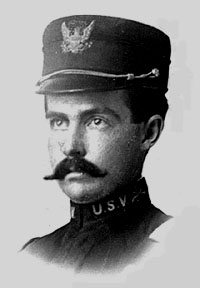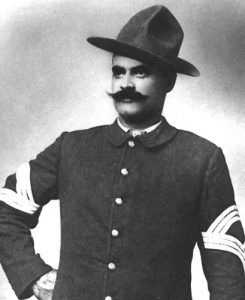
Tibor "Ted" Rubin was a Hungarian-American Army Corporal. A Holocaust survivor who immigrated to the U.S. in 1948, he fought in the Korean War and was awarded the Medal of Honor for his actions during the war, as a combatant and a prisoner of war (POW).

Sergeant Major Ernest August Janson was a United States Marine who was highly decorated for his heroic actions in World War I. He was awarded both the Army and Navy Medal of Honor, the French Médaille militaire and Croix de Guerre as well as decorations from Italy, Montenegro and Portugal. During World War I he served under the name Charles F. Hoffman.

Harry Chapman Adriance was a United States marine who received the Medal of Honor for his "distinguished conduct in the presence of the enemy in battle near Tientsin, China" on July 13, 1900, during the Boxer Rebellion.

Edward Lee Baker Jr. was an African-American United States Army Captain who received the Medal of Honor for actions during the Spanish–American War. While under fire, he rescued a wounded soldier from drowning.

Charles Goodwin Bickham was a United States Army first lieutenant who received the Medal of Honor for "distinguished gallantry" on May 2, 1902, in the Battle of Bayang, during the Moro Rebellion. Lieutenant Bickham carried a wounded soldier across a "fire-swept field".

William Edward Birkhimer was a United States Army brigadier general and lawyer received the Medal of Honor while a captain during the Philippine–American War. His career was long and varied, as he started as an Iowa private in the Union Army during the Civil War. He is buried in Arlington National Cemetery.

Arthur Medworth Ferguson was a United States Army officer who received the Medal of Honor for actions on September 28, 1899, during the Philippine–American War. He later obtained the rank of lieutenant colonel. He had previously been promoted from Corporal after being awarded the Distinguished Service Cross for actions on April 26, 1899. Colonel Ferguson is buried in Arlington National Cemetery.
Sterling Archibald Galt was a United States Army Sergeant Major who received the Medal of Honor for actions on November 9, 1899, during the Philippine–American War. He later obtained the rank of Sergeant Major. Sergeant Major Galt was born in Taneytown, Maryland.
Louis Gedeon (1877-1950) was a United States Army private who received the Medal of Honor on February 4, 1900. During the Philippine–American War.

Benjamin Brown was a Buffalo Soldier in the United States Army and a recipient of America's highest military decoration—the Medal of Honor—for his actions during the Wham Paymaster Robbery in the Indian Wars of the western United States.

John Denny was a Buffalo Soldier in the United States Army and a recipient of America's highest military decoration—the Medal of Honor—for his actions in the Indian Wars of the western United States.

Clinton Greaves was a Buffalo Soldier in the United States Army and a recipient of America's highest military decoration—the Medal of Honor—for his actions in the Indian Wars of the western United States.

Isaiah Mays was a Buffalo Soldier in the United States Army and a recipient of America's highest military decoration—the Medal of Honor—for his actions during the Wham Paymaster Robbery in Arizona Territory.
Emanuel Stance, also known as Edmund Stance, was a Buffalo Soldier in the United States Army and a recipient of America's highest military decoration—the Medal of Honor—for his actions in the Indian Wars of the western United States.

Edward Herrick Gibson was a United States Army Sergeant received the Medal of Honor for actions during the Philippine–American War. He was awarded the Medal for the same action as Corporal Antoine Gaujot. The Medal was received for actions on December 19, 1899, at the Battle of Paye near Mateo during the Philippine–American War. Gibson is buried in Golden Gate National Cemetery in San Bruno, California.
James Robert Gillenwater was a Corporal with Company A, 36th Infantry, United States Volunteers when he received the Medal of Honor for actions near Porac, Luzon, Philippine Islands, September 3, 1899. Date of issue: March 1, 1902. He was born and entered service at Rye Cove, Virginia.

Julien Edmond Victor Gaujot was a United States Army Medal of Honor recipient.
Thomas Francis Prendergast or Pendegrast was a recipient of the Medal of Honor for his United States Marine Corps service in the Philippine–American War.

Clarence Edwin Sutton was a United States Marine Corps sergeant who received the Medal of Honor for his actions during the Boxer Rebellion.

Stephen Rought was a sergeant in the United States Army who was awarded the Medal of Honor for gallantry during the American Civil War. He was awarded the medal on 1 December 1864 for actions performed in May 1864 in the Battle of the Wilderness in Virginia.















